Design Considerations
Of course multi-player games present significantly different challenges in their design than do single-player games. For example, the pacing of multi-player games needs to be more varied than it is in single-player games, for the simple reason that in a multi-player game players cannot pause the game, since the other players would need to simultaneously pause as well. Though most single-player games provide a variable curve with peaks at high tension and valleys in calmer moments, getting this curve right is even more important in a multi-player game since players are unable to create their own valley by hitting the pause button. Without being able to pause their game, players run the risk of being slaughtered by the other players if they let their guard down for even a moment. It is human nature (at least, for everyone except for the most hard- core ) to need breaks from any activity, and a designer should plan his game so it is possible for players to tend to the needs of the real world without needing to quit the game. This may mean letting them choose how long to wait to respawn after dying, providing safe places in the world for them to hide without the immediate threat of death, or having a short enough game duration that wanting to pause is not a major issue.
If possible, you want to predetermine how long it will take players to play your game, at least on average. You want to pick a time that will be a reasonable investment for your target audience, and then try to make the design of your game support that length. Most players want to know how much time they need to play your game, since all but the most hard-core have a variety of things to do with their lives other than playing games. It is a very different decision to play an online game of hearts versus going on an epic adventure in EverQuest or starting up a multi-player game of Civilization III . In board games, Monopoly is a good example of a game that many people refuse to play because they know how long it can take in the worst cases. Games can drag on for days. Risk and Diplomacy provide even more extreme examples of this same problem. If players find a game is going on too long for them (either as an aberration or standard operating procedure) they are likely to drop out in the middle of the game, something that can be very frustrating to the other players. Letting players know what they are getting into before they start up a game is a good way to encourage them to play games all the way through.
Similarly, if at all possible you want your game design to allow players to feel that they still have something of a shot at success even when they are losing. Games that allow one player to get extremely far ahead of the other players but still require a long and tedious end-game for that player to complete the win will encourage the losing players to drop out, essentially forfeiting. Though this does not need to be disastrous, it is better if your game is designed so that players never feel like all hope is lost. One way to accomplish this is through employing negative feedback systems to give players who are falling behind a better chance of catching up. At a talk at the Game Developers Conference, Marc LeBlanc discussed how positive feedback systems can push the player who is ahead in the competition even farther ahead, while negative feedback will keep the competition close. For example, in a racing game, if there are guns mounted on the front of the vehicles, players who are behind can shoot at the players who are ahead, thus closing the gap. If the guns are mounted on the back of the cars , however, the feedback is positive, allowing the winner to take out the opponents who are already behind it. Therefore, with its front-mounted guns, Mario Kart is a good implementation of negative feedback that helps keep the races closer and thereby more exciting.
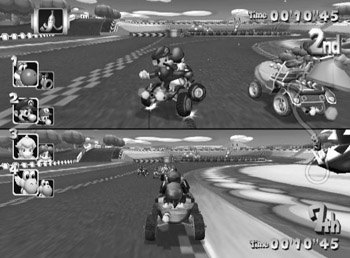
With its front-mounted weapons, Mario Kart is an excellent implementation of negative feedback keeping races close between competing players. Pictured here: Mario Kart: Double Dash .
Of course, players will still drop out of your game regardless of how much you try to discourage them. Indeed, due to the somewhat chaotic nature of the Internet, some players may get dropped from the game in the middle through no choice of their own. Your game will need to handle these dropouts in an elegant way such that the remaining players can continue playing if at all possible, with the now-missing players having essentially forfeited their slots. You may wish to allow them to reclaim their spots in the game if they reconnect quickly enough, to forgive unavoidable Internet flakiness. If having players drop out in the middle is not handled well by your game, you are almost surely doomed to frustrating the players who want to keep playing.
Allowing players to customize their avatar in the game-world is also key to making players feel that they are actually putting themselves into the game. This can be as simple as picking their name or handle, or choosing their color . Players will also enjoy picking the base talents of their character, whether this means deciding between infantry, medic, or engineer in Battlefield 1942 or between paladin, ranger, and sorcerer in an RPG. Different players will gravitate to different classes based on their skills and personalities. For those who want to take it a step further, empowering players to alter their body type, skin color, and clothing can go a long way to helping them immerse themselves in the experience. Just as people enjoy dressing up in real life as a way of communicating to others what type of person they are, they will also fancy it in an online space. Interestingly, however, players will primarily enjoy adjusting those traits of their avatar that will not actually impact their success in the game. They ll love to pick eye color or hairstyle, but it will take players with a fervent interest in role-playing to play a gimpy character with weakened stats to match its physical impairments.
In Chapter 7, The Elements of Gameplay, I talked about emergent gameplay and allowing for multiple player tactics to lead to success. While these sorts of significant player choices are important in single-player game experiences, in multi-player they are absolutely essential. In a multi-player game, players are not thinking What does the designer want me to do here? but instead What tactic can I come up with that will allow me to win against these equally clever other players? If your game design does not allow for a flexible enough space for players to develop unique tactics to counter other players moves, all but the newbies will quickly lose interest in your game. With multi-player games you have the advantage of not needing to come up with ways to directly challenge players, but you need to provide the palette of potential actions that will empower players to challenge each other. For example, rocket jumping may not have been planned as part of the design of Quake or its rocket-jumping predecessor Marathon , but the robustness of the technology and design of these games supported the players innovative tactic. Fundamentally, multi-player designers have much less dictatorial control over players experiences than do single-player designers, and it is in their best interests to recognize this and work to empower players instead of constraining them.
Playing to Strengths
Often when designers move from single-player games to multi-player, the first thing they think of is replacing their AI adversaries with human ones. This is a choice that is guaranteed to lead to a more challenging and dynamic experience for the user . But at the same time, it fails to truly explore the full potential of multi-player games. For years , single-player games have been built around the limitations of what an AI could and could not do. Many action games, for example, have balanced their gameplay by throwing a large number of fairly dumb AI agents at players. When these same games became death-match online games, designers typically replaced these dumb AI creatures with human players but, in order to balance the game, drastically decreased their number and made the players fight for themselves. Whereas there were two factions previously (the player and the enemies), now there were as many adversaries as there were players. These simple choices managed to rebalance the game experience fairly well. But these combat games were still not close to exploring the full potential of multi-player games, because these human players could just as easily still be really smart bots. In Chapter 9, Artificial Intelligence, I talked about how an artificial intelligence can be considered to pass the Turing test if players mistake it for a human. For multi-player games, the goal should be somewhat different: players could never mistake their adversaries for anything but other humans .
To create a distinctly multi-player game experience, it can be valuable to take a cue from the rich history of multi-player non-computer games, particularly games that require more than two players. For example, many of the more sophisticated board games involve negotiation between players via trading and bartering or establishing alliances. Excellent examples of both mechanics can be found in any playing of seminal multi-player games like Diplomacy , Cosmic Encounter , and The Settlers of Catan . In many three or more player board games, deciding who the various players will gang up on at any given time is a key part of the play experience. This can help to fix whatever balancing issues the game design may have, since as soon as one player gets significantly ahead of the other players through luck or an exploit, the other players will quickly gang up on him. In such games, the personalities of the gamers inevitably come into play, whether through going easy on the less skilled player who gets upset easily or a hidden vendetta against a spouse that does not manifest itself except during gaming sessions. Dungeons & Dragons and other RPGs allow players to play together in a group , with the Dungeon Master creating a dynamic game experience for the other players in a way a computer never can. An online game with players located miles away from each other and who are most likely real-world strangers will probably never recreate the in-person multi-player experience. Nevertheless, the more successful online games include components that force players to socialize as part of the game mechanics, and thereby make the social interplay in the game that much richer. This includes seasoned players coordinating their tactics in team-based multi-player games like Counter-Strike or Battlefield 1942 , or the recreation of the Dungeon Master experience in Neverwinter Nights .
Though the potential for players to cooperate should be a key part of almost any multi-player game, getting players to actually do it is another problem entirely. Battlefield 1942 lead programmer Johan Persson has lamented at how infrequently most players exploit the game s more cooperative features, such as one player scouting and providing coordinates to another player who fires artillery . One way to improve the chances of player cooperation is to make sure that players who work together have a significant advantage over those who do not. It stands to reason that if there is a complex cooperative option available that does not provide significant benefit over what one can accomplish alone, most players will choose to just do it all themselves. An early example of this comes from Joust , which had survival levels where two cooperative players received a large score bonus only if both of them did not lose a life during that level. When there is a significant advantage to cooperating in a team versus team style game, there may be the unfortunate side effect that more casual players will get crushed by the opposition and thus may never live long enough to enjoy the game. Of course, for all but the most sadistic, crushing weak opponents is only fun for so long, so most cooperative gamers form clans and fight against other clans on servers that are labeled and restricted accordingly .
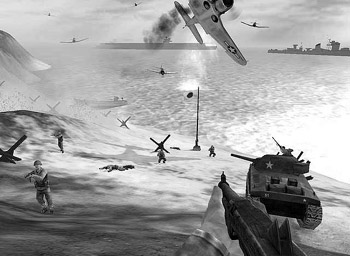
Battlefield 1942 requires players to work together to be truly successful, creating a unique experience that cannot be replicated in a single-player game.
Protect Newbies
Newbies are the most vulnerable players, and it is the game designer s job to do everything he can to keep them protected long enough for them to become familiar with the game s mechanics and tactics. This is essential to your game s long- term success. Unlike in a single-player game, where the designer has ultimate control over the players learning experience, in a multi-player game your new players are immediately at the mercy of the more experienced players who are likely to show newbies no quarter. When I first started work at Surreal Software, the company was close to shipping the original Drakan game. They were spending a lot of time testing the multi-player code, and I was quickly sucked into playing multi-player games with the development team. Of course, they had been playing the game for many hours a day for at least a year, and had been focusing on the multi-player game for several months. As a result, they knew it backward and forward, while I had no idea what was going on. The game s melee combat system was particularly unforgiving to new players, so I was soundly beaten again and again without ever even realizing why I was getting killed . I recall breaking several mice in frustration. If I had not been getting paid to do this testing, I surely would have quit the game and never played it again.
Though my problem was an extreme one, this is approximately the experience of many newbies who do not have time to properly prepare for an online player-versus-player encounter. For a more disastrous example of newbies getting beaten off before they have a chance to really become familiar with the game, one needs to look only as far as the history of the online combat flight simulator market. These are some of the oldest online combat games, and seem to be ideally suited to multi-player gaming. But the community never grew beyond the super-hard-core flight simulator buffs. One reason for this was that the controls for these flight simulators were so challenging to learn and the physics so difficult to wrap your head around that most players had trouble even keeping their planes in the air for very long. Throw in seasoned players who showed no mercy in taking out these newbies, and you have a market that never extended beyond a certain limited size . In the end, the games were simply too unforgiving toward new players.
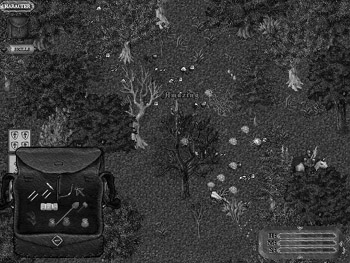
The original Ultima Online had many hostile users known as playerkillers who made the game especially challenging for newer players.
To make matters worse for newbies, it is a rule of thumb in online game development that some fixed percentage of players, say one percent, are complete jerks (or at least become jerks when playing online games) and love to prey on new players who do not stand a chance against them. Though this may only be one percent of your audience, unfortunately they are typically the most tenacious and tireless of players. Many of the multi-player combat games have tried to partially solve this problem by including single-player training areas in their games. Ultima Online , the first commercially successful massively multi-player game, was particularly plagued with player-killers when it launched. This despite the fact that the game, unlike death-match style games, was not designed to emphasize players killing other players. To many players this resulted in a significant barrier for entry. Almost all subsequent MMPs fixed this problem in various ways. One solution requires player-killers to register as such and then allows them to only attack other player-killers. Another technique involves segregating new players in safe zones for a time before allowing them to go to more hostile locations. Indeed, even Ultima Online eventually fixed the problem by creating a mirror of the world that was safe and then allowing the players who were looking for a less hostile environment to migrate over to it.
Protecting newbies is a concern online game designers will always need to deal with and for which there will probably never be a perfect solution. As I mentioned previously, offline training areas can be extremely helpful for players to practice without the shame of being crushed by human opponents repeatedly while they try to get up to speed. Instead of always rewarding players for killing other players, Dani Bunten Berry suggested that a mentoring system may be appropriate, where more veteran players are appropriately rewarded for watching over the newer players. Indeed, Asheron s Call implemented just such a system through allegiances, which worked quite well in giving players a large incentive to help each other, particularly newbies.
Keeping features to a minimum and controls as simple as possible will also help. The more complex and hard to understand the controls are, the longer it will take someone to get used to them, and then the further ahead the experienced players will be from the novices. The air combat flight simulators are a perfect example of too complex controls creating a hard-core-only gaming community. Having simpler controls but combining them with a deep range of actions and tactics helps keep the barrier to entry reasonably low while providing the experienced players with raw materials with which to experiment. Finally, if your game design supports something more complex than I win, everyone else loses gameplay, the game will be a lot more inviting to new players. Massively multi-player games have become particularly good at this, allowing all players to go on all the quests and supporting players succeeding in a variety of equally satisfying ways. Many death-match games show the ranking of players at the end of the match instead of just reporting the winner. This way, though it may be a while before a newbie moves to first place, he can see himself crawl out of sixteenth place and up to higher ranks over time. To players, there is less shame if they come in fifth out of eight than if all they know is that they failed to win.
Socialization
One of the primary reasons that players engage in multi-player games is to socialize with other players. This is true both in computer games as well as non-computer games. Anyone who has played board games with his family can attest to the fact that one person is always suggesting they play a game while some others will go along just to have something social to do, not because they are particularly captivated by the gameplay itself. Indeed, when I first started playing Dungeons & Dragons I was not very interested in the game at all (indeed, I would have much rather played Champions ). But Dungeons & Dragons was what my friends wanted to play, and rather than stay home and do nothing I joined in. I only came to appreciate the gameplay after playing with them for some time. Similarly, I knew people in college who became so wrapped up in a givenMUDthat friends of theirs would start playing theMUDjust so they could socialize with them again. Certainly a large number of people playing massively multi-player games such as EverQuest today primarily do so in order to socialize. This also explains why these games have attracted a larger female fan base than, say, first-person shooters: the commonly held wisdom is that women enjoy socializing more than men. At the very least, females are looking for a social experience a little more involving than a game that revolves around kill-or-be-killed mechanics.
With a board game or a non-computer role-playing game, the players ability to socialize mostly comes free. Nevertheless, a game like chess is far less social than a game that requires players to cooperate or backstab each other. In a multi-player computer game with all the players playing around one screen, such as Mario Kart or a split-screen death-match game like Halo , socialization also comes largely for free, though if the game is too frantic and intense in its pacing then the players ability to socialize may be more limited.
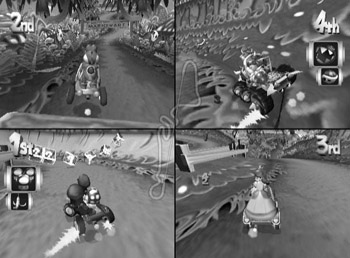
With a split-screen multi-player experience, as found in Mario Kart: Double Dash , you are almost guaranteed a very social experience for players.
For an online game, the designer will need to go out of his way to facilitate player socialization. The first step is providing an interface with which players can chat among themselves. Almost all online games do this, though some of the earlier death-match and casual games did not. Similarly, some online games aimed at children have been forced to leave out chat options for fear of adults abusing such a system to obtain a child s address. For example, the children-oriented MMP Toontown Online allowed communication only through a symbol-based language. Assuming you are not legally prevented from adding full chatting, you want to facilitate conversation in all parts of the game, not just during active gameplay. For short-duration combat games, if there is a lobby where players wait for the game to start once all the players have joined up, this is a perfect place for conversation since players otherwise have nothing to do. You should also enable conversation on any post-game screen where player rankings are displayed; players will want to be able to talk here in order to discuss what just happened , either to brag or to congratulate and vow revenge in the next game.
Of course, chatting via keyboard is significantly inferior to the expressive potential of actual human speech, with the obvious advantage that players can talk while continuing to play the game. Indeed, the use of emoticons and creative punctuation may do their best to imbue text with the emotional depth of speech, but only go so far. Speech communication between your players comes for free if your game is not online and your players are all playing around a single screen. Anyone who has ever played a first-person shooter over a LAN with all the players sitting in close proximity to each other (such as after hours in a campus computer lab) can attest to how much fun playing against players who are close by can be, with players screaming in surprise when they are killed unexpectedly, cursing each other for cheap shots, taunting each other that their time left to live is limited, or proclaiming their vast superiority over their opponents. This type of socialization has proven so popular that players who are either in separate parts of the same building or in separate offices entirely have been known to teleconference themselves together in order to recreate a space where they can socialize via voice. This also explains the burgeoning popularity of headset support for online games on the consoles; players really want to be able to talk to each other while playing. The largest downside to adding voice support to your game is the negative impact it can have on the sense of immersion you get from playing the game. Despite its simplistic Indiana Jones version of World War II, playing Battlefield 1942 can often be an extremely immersive experience with its combination of planes flying overhead, explosions going off all around, and battles for control points truly seeming like important skirmishes in an epic struggle. This immersion can be dashed if you hear a twelve-year-old on the other side of the headset screaming complete nonsense or nonstop obscenities. In the end, though, most players are likely to find the loss of immersion to be well worth it for the improved ability to communicate and play cooperatively, as well as the sheer pleasure of hearing their fellow players screaming their way through the battle.
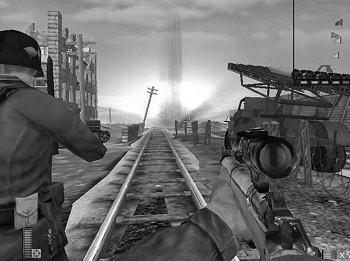
At times, waging multiplayer war in Battlefield 1942 can be extremely immersive.
Another important part of facilitating player communication is giving players time where they feel safe enough that they can talk without being killed. This is particularly true in intense death-match style games, where there is hardly enough time to compose a five-word sentence before a grenade lands in your lap. Of course, including voice support will help this, but anyone who has played a truly intense action game can testify to how mesmerizing and frantic it can become, often to the point where talking and playing may be too much to ask. Thus the importance of pacing the game such that players have opportunities to talk. Similarly, the higher the glory to shame ratio in your experience, the less likely players are to be willing to talk, since each defeat is so tremendously humiliating, particularly when the winner will not stop bragging about it.
Just adding the ability for players to talk via text or even full voice support and making-sure players have free moments in which to compose at least partial sentences will not guarantee a social play experience. A large part of the reason why players enjoy playing non-computer board games or RPGs is that they are playing with friends that they are familiar with and whose company they enjoy. Playing with random people over the Internet is much less likely to be enjoyable if you only know these players for the duration of a death-match game and then switch to a totally new set of people with every new match. Players will never get a chance to know each other. Therefore, having a game experience that encourages players to formclans or guilds that need to work together to succeed will be essential to creating a more social experience for your players. Fostering relationships between players that last beyond the time they are playing the game will not only benefit the players themselves but also the long-term success of your game. Those players who became friends playing your game are likely to get together to play as a social event in the future, assuming they still enjoy the game and it allows them to strengthen their friendship while playing. These players are also more likely to talk to each other on forums dedicated to your game, which can help build up your community and attract other players to your game in the future. The community surrounding an online game is even more important than the community for a single-player game, and allowing players to have a rich social experience in your game can help build this community better than anything else you could possibly do.
Every feature or play mechanic you add to your multi-player game should be examined to determine how it impacts the players social experience. Though not every feature needs to be a social one (it is still a game, after all, and most likely a competitive one), any feature that actively disrupts the players ability to socialize and work together needs to be carefully considered to make sure the impact it will have on the game will be worth the cost. Indeed, having features that do nothing to improve the game mechanics directly but do help the players socialize will often end up improving the players overall experience with your game. Allowing players to communicate with each other is one of the most compelling aspects of multi-player games and is something that a single-player game will never be able to provide in any sort of meaningful way.
EAN: 2147483647
Pages: 189